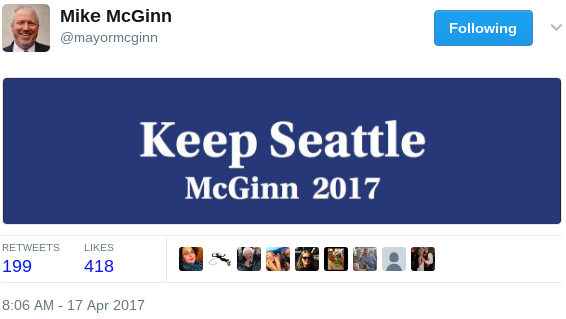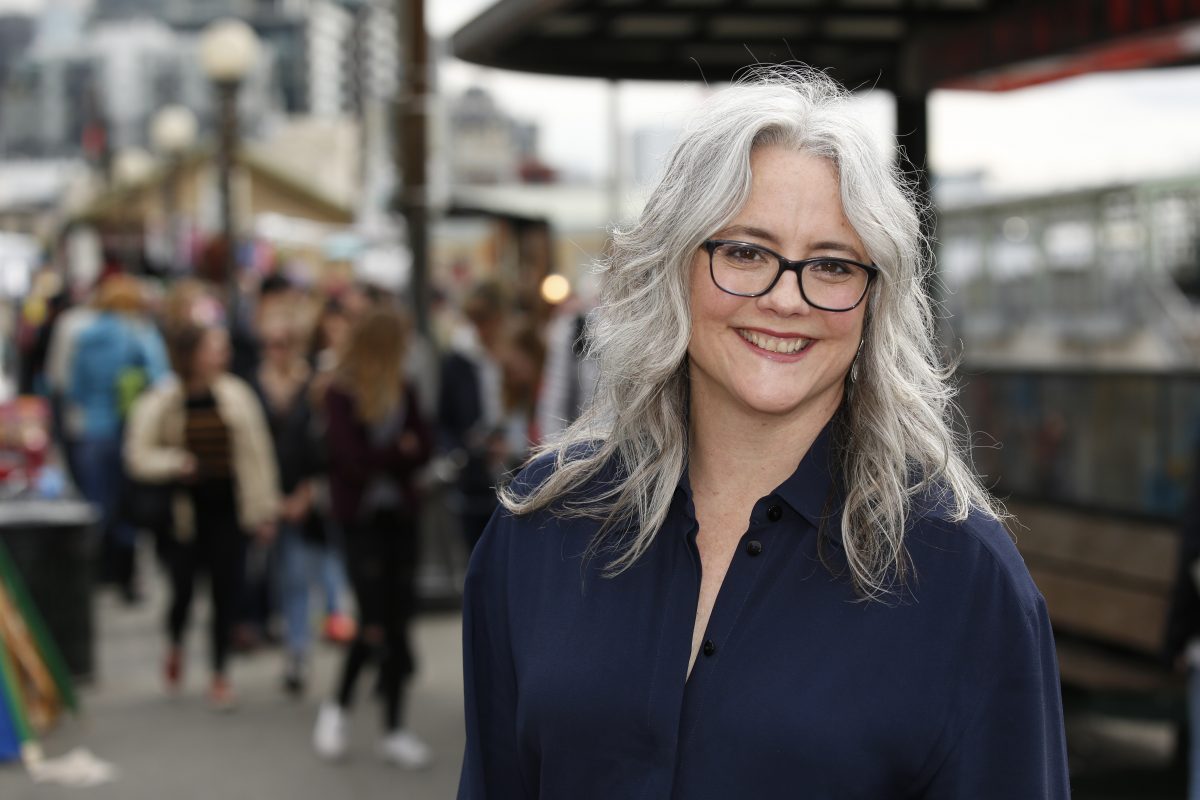
Former Mayor Mike McGinn declared Monday he’s joining the race and seeking a rematch against Mayor Ed Murray, who beat him by 8,500 votes in 2013. It’s not just Murray and McGinn in the race. Lawyer/poet/activist Nikkita Oliver might have something to say about that. Plus, a fourth major candidate declared today: Cary Moon, who is an urban planner that campaigned against the SR-99 car tunnel with Waterfront Seattle.
What do all the major challengers have in common? A chorus of urbanists have branded each of them “NIMBYs,” which is short for Not In My Back Yard activists. It seems a matter of time before Moon gets similar treatment.
Not Using NIMBY In My Backyard
Now in these urbanists’ defense, all of the major candidates–Murray included–have said things that could be construed as anti-growth or “NIMBY.” We try to avoid using the term NIMBY on this website, because the term can be inflammatory and imprecise. The word has grown to encompass such a broad range of ideas. Oppose any particular upzone? NIMBY. Oppose cutting design review? NIMBY. Speak about the benefits of homeownership? NIMBY. Suggest some growth should go to suburbs? NIMBY. Question some aspect of supply side housing economics? NIMBY.
Pushing back against anti-growth ideas can be worthy, but when basically doing anything market urbanists don’t like is “NIMBY” then it’s a blunt term to use. Richard Florida has proposed “New Urban Luddite” as an alternative term to NIMBY, but luddite could seen as equally offensive. Let’s just use anti-growth as appropriate.
Is McGinn Dogwhistling To Anti-Growthers?
The reaction to McGinn and his admittedly cryptic campaign slogan, Keep Seattle, was ‘McGinn is a “moderate” and a “NIMBY” now?’ McGinn swept into office in 2009 viewed as an outsider and riding an urbanist wave. One of his signature issues was opposing the SR-99 car tunnel, and he was seen as a dogged advocate for bicycling and pedestrian issues to the point opponents branded him “Mayor McSchwinn.” This isn’t the type of guy you’d expect to see cavorting with John Fox (noted anti-growth propaganda purveyor with the Seattle Displacement Coalition.)

Moreover, since leaving office, McGinn wrote thoughtfully about who speaks for neighborhoods and suggested traditional neighborhood groups aren’t representing renters and people of color well enough. He also ridiculed Brier Dudley’s “war on cars” screed and defended Seattle as a multimodal city, much like other urbanist bloggers at the time.
So what exactly did McGinn say on Monday that was so upsetting? Well, at his announcement McGinn made a nod to “neighborhood driven planning process” and “inviting everyone in” about growth. Some interpreted this as a dog whistle to anti-growth forces, but inclusive process isn’t necessarily a bad thing if it doesn’t lead to undue delays to much needed housing growth.
Even if McGinn is trying to reach out to the neighborhood groupies, it’s not clear that’s an alliance they’re interested in. For one, McGinn is also talking about reviving the push for townhomes in detached single-family zones–a policy not particularly popular with that crowd (see: HALA single-family backlash). Plus, they haven’t really been a strong McGinn ally in the past.
Perhaps McGinn’s neighborhood olive branch represents an electoral reality–urbanists alone aren’t a large enough constituency to beat an incumbent–rather than a fundamental shift in policy approach.
Enter Cary Moon and Her Housing Vision

For a first-time candidate, Cary Moon does have a relatively fleshed out housing platform thanks in part to a four-part series she co-wrote with Charles Mudede last year. Like McGinn, she points to more missing middle housing (i.e., triplexes, rowhouses, and small apartments) as an important solution. A less talked-about policy she adds ares taxes on luxury real estate, on capital gains, and on foreign capital. Moon argues this would reduce speculative practices and profiteering. But the rhetoric she used in her co-authored Stranger piece seems likely to rile some market urbanists:
3) Put up immediate defenses against the influx of Wall Street and global capital. The excess capital idling in our global economy operates with the efficiency of heat-seeking missiles when it finds a target, and our hot housing market is just sitting here vulnerable and defenseless. What can our city and county government do right now to deflect their interest and protect our housing stock? How about instituting an owner occupancy requirement? How about requiring all shell companies to fully disclose ownership? How about inventorying all our affordable housing and demanding a one-for one replacement in any proposed redevelopment (something that should have happened with Hope 6, a Federally funded program which demolished big chunks of our public housing stock without replacing a lot of it, and thereby displacing thousands of families, most of whom were black)? How about instituting a policy––and building a civic culture––of selling to human Seattleites who need a place to live as a first priority? …
Policies like one-to-one replacement of affordable housing and restricting global capital seem ripe to be branded as “anti-developer” by market urbanists. Her campaign website has winnowed the above down to “implement targeted taxes or other mechanisms to deter corporate and non-resident real estate speculation to strengthen neighborhoods.” Vancouver has had some success with its foreign buyers tax so it seems worthy of exploring.
Nikkita Oliver’s Anti-Displacement Message
Nikkita Oliver received the brunt of “NIMBY” accusations after she mentioned a “pause” on development during a Shadow Council event and praised a Brier Dudley article opposing upzones. Lost in the uproar is an honest discussion of how to keep Black and Brown people from slowly being erased from Seattle as the Central District gentrifies and Black folks are displaced and pushed ever southward. Are we doing enough to mitigate displacement and address the racial equity gap in the Central District? The answer seems to be no.
The Central District case is unique in that the formerly red-lined neighborhood is now a booming trendy place to live. The area’s former Black majority has shifted with Blacks now making up less than 20% or the population. Moreover, Black cultural amenities and storefronts are getting priced out or replaced, too. Black Dot, a community space focused on Black entrepreneurs, is in the process of being evicted from its tenant space; this morning Seattle police officers threatened Displacement Stops Here members who were standing guard with trespassing to remove them from the building. At stake is the future of a mega-development the MidTown Center’s owners plan to bring to the 23rd and Union site with upwards of 500 apartments, even as their deal with Lennar fell through.
Oliver hosted her campaign kickoff in the Central District and highlighted the displacement happening there; her campaign could make a powerful case we need to do more to prevent it. Broadly speaking, labeling our opponents NIMBYs or luddites doesn’t negate valid criticisms when they articulate them. Listening to gentrification concerns and being more thoughtful about throwing around labels would probably do the urbanist movement some good.
We have a slate of good mayoral candidates. Let’s listen to what they all have to say.
The featured image of Mike McGinn at the Ballard Neighborhood Greenway cutting is by Dennis Bratland.
Doug Trumm is publisher of The Urbanist. An Urbanist writer since 2015, he dreams of pedestrian streets, bus lanes, and a mass-timber building spree to end our housing crisis. He graduated from the Evans School of Public Policy and Governance at the University of Washington in 2019. He lives in Seattle's Fremont neighborhood and loves to explore the city by foot and by bike.


